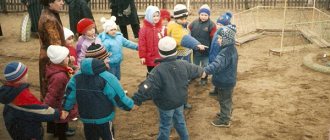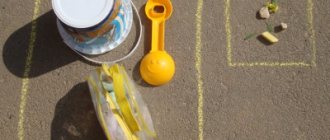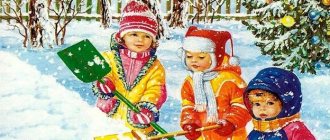Olga Andreeva
Card file of winter walks in the preparatory group
Observation #1
Observing changes in nature. Offer to look for signs of winter on your own.
Riddle: Powdered the paths,
I decorated the windows.
Gave joy to children
And I went for a sledding ride. (Winter)
Didactic game “Who is bigger?”
- practice selecting definitions for nouns.
What words can you use to describe winter? What's winter like? (magical, fairy-tale, snowy, frosty, blizzard, sparkling, magical winter, cold, beautiful, etc.)
Monitoring seasonal changes
Goals:
• form ideas about changes in nature at the beginning of winter (the night becomes longer and the day decreases)
;
• learn to distinguish the characteristic signs of the beginning of winter, recognize them in poems.
Preview:
WALK 1
SKY WATCHING
While walking, observe the color of the sky and how it changes depending on the time of day and the weather. If there are no clouds in the sky, admire the beauty of the blue sky, the brightness of its shades, and the speed of the clouds. Remind why clouds move. Bare trees covered with fluffy snow look very beautiful against the sky. Ask the children to compare the sky in different seasons.
Signs: a reddish sky in the evening, and a grayish one in the morning promises good weather; the sky seems high - towards the bucket.
Sayings and proverbs: “Winter frolics not only in the forest, but also on our noses.”
Poem by V. Orlov “Everything is angrier, angrier, angrier...”.
Riddles about snow.
Didactic game “Who needs what?”
Outdoor game "Bubble".
OBSERVING THE SKY AND EVENING SCENERY
Observe the evening sky to see if there are stars and a moon in it. Admire the beauty of the evening landscape in the light of the lanterns. In evening light, all objects look different: more mysterious and mysterious. The teacher suggests watching how the snow falls in the light of the lanterns, how the snow lying on the ground, trees and objects sparkles.
Signs: the night sky is starry - there will be sunny, frosty weather; if small stars are not visible in a clear sky, then a storm will occur.
Sayings and proverbs: “New Year – a turn towards spring”; “As the day grows, so does winter.”
Poem by A. T. Tvardovsky “Winter Again.”
Riddles about the sky.
Didactic game "Guess it."
Outdoor game "Cook".
Goal: to develop rhythm, expressiveness of speech and coordination of movements.
Progress of the game. All children stand in a circle. The driver walks around in circles. He has a chef's hat in his hands. The children recite the poem in chorus:
Let's play cook, no one can yawn,
If you are the cook, then quickly go around.
After the words “Hurry up and walk around,” the driver stops and puts the cap on the child standing next to him. The person who received the cap and the driver stand with their backs to each other and, at the teacher’s signal, walk in a circle. Whoever goes around (not run) the circle first wins and becomes the driver.
Fun game “Who is faster?”
Goal: develop agility and speed.
Progress of the game. Sled competition. A circle is drawn in the snow, in the center of which there are 3-4 children with sleds. Their tasks:
Take the sled out of the circle, holding the back;
Exchange sleds, sit down and ride out, helping yourself with your hands and feet;
Before you sled out of the circle, you need to throw a snowball at the target.
Experimenting and experiences while walking in winter
Preschool age is characterized by a special interest in the world around us. Often, a child cannot notice some fundamental things on his own, so it is important for a teacher to teach him not only to look, but also to see. Theoretical knowledge should be supported by visual material and experiments that can enrich children’s knowledge.
Experimentation on walks is divided into two types:
- Frontal - when children have several objects to observe and compare independently. For this type of observation, it is recommended to have two teachers monitoring the students, especially if the group is large.
- Demonstration - the teacher holds in his hands the object that has been selected for teaching. The teacher demonstrates the object and conducts an educational conversation. This method dampens initiative and activity; as a rule, preschoolers are not very interested in activities in which they must only observe without participating.
Card file of conversations in the preparatory group in the morning
Important! Experiments that will be conducted with children must be selected in accordance with their development and age.
Experiments for preschoolers are not entertainment, but a way of teaching children, their acquaintance with the environment and life. Such walks can be done in the format of an open lesson, with the invitation of parents.
Card index of walks "Winter" For older people
№ 27Comparative observation of bullfinch and waxwing
Target
– using the example of comparing the bullfinch with the waxwing, study the features of their structure, lifestyle (feeding, movement);
cultivate an educational interest in birds.
Conversation
Who has a breast brighter than the dawn? (At the bullfinch.)
Northern guests
Rowan berries are pecking at clusters.
So elegant and bright
There are tufts on the heads!
(Waxwing.)
What does a bullfinch look like? (The male bullfinch has a bluish-gray back, dazzling white undertail, black tail and wings, and a bright red breast. The female is more modestly colored - her breast is not scarlet, but dark gray.) What does a waxwing look like? (Her plumage is elegant, pinkish-brown, lighter on the chest and belly and darker on the back. The waxwing’s head is decorated with perky silver-pink crests.
And on the wings, as if drawn with a bright red pencil, there are even stripes.) What do they have in common? (These birds are migratory; bright plumage; they are residents of the north; they love rowan berries.) How does a bullfinch differ from a waxwing ?
(Size: the bullfinch is slightly larger than a sparrow, and the waxwing is the size of a starling, has a crest; plumage is colored.) Do we see these birds at feeders? Why? (These birds can be seen on rowan and viburnum bushes, as they feed on the berries and seeds of these plants.)
Is it possible to determine by the rowan berries scattered on the snow who fed on them? (Waxwings drop them on the snow, and bullfinches eat only the seeds, throwing out the pulp.) Do you know how bullfinches and waxwings behave? (Bullfinches leisurely fly in small flocks from tree to tree tree, slowly pecking at the berries. Waxwings are fast, nimble, timid; they fly in large flocks, pecking greedily and hastily.)
Work.
Spreading sand on slippery paths.
P/n:
“Owls”, “Birdhouses”. Skiing.
Individual work. Didactic games.
“Decide.” "What's extra."
Finger gymnastics
"Bullfinch".
Independent play activity.
Games with snow.
№ 29
Crow and Magpie Watching
Target
– consolidate the idea of the bird world, know their characteristic features.
Conversation
Magpie-Crow
Looks From Above,
From above to the sky
From an upside down branch.
Guys, look what a guest we have on the site. (Crow.) What
do you know about her? What is her character like? Why don't people like crows?
What's positive about it? The crow is called the gray robber.
Many do not like crows for their impudence and thieving habits. But still
We don’t have a bird smarter, more cunning, more resourceful: it will open a package of milk, and soak a stale cracker in a puddle, and crack a walnut. And if anyone decides to get close to the crow’s nest, beware. Neighbors will gather from all over the area, and together they will drive away the uninvited guest with a loud croak. The raven is the largest of the crow family. Raven and crow are completely different birds. You won't even see them together. Raven is a forest bird. In many fairy tales the crow is called wise. Maybe because this bird lives up to a hundred years. Do you know crow relatives? (Rook, jackdaw, magpie.) What magpie? What are the similarities and differences between crows
and magpie? You know Magpie well. Forest inhabitants respect the magpie. She has a long tail, flies everywhere, hears everything, knows everything. A magpie chirped in the bushes - the animals became wary and hid
birds. "Danger, danger!" - the magpie chirps, and
everyone understands her language.
Work.
Collective work on site.
P/n:
“The Kite and the Hen”, “Don’t Get Caught”. Badminton game.
Individual work. Didactic games.
"Guess the figure." “Put the word together.”
Finger gymnastics
"Crow".
Independent play activity.
Sledging.
MAGAZINE Preschooler.RF
“How do you know winter?” Open demonstration of the walk in the preparatory group(Children get dressed and go outside)
Educator: “Come in, kids: Both girls and boys! I ask everyone to stand in a circle - take each other’s hands!
Look at each other and give smiles! I didn’t come to you alone - I brought guests to the site!
Say hello, guys (children say hello)
(A letter is brought out, the teacher reads):
- Hello, preparatory group guys! Employees of a research institute are writing to you. We are studying the Arctic and the characteristics of the winter season. On December 17, an international conference on this issue began in Moscow. Research by scientists on studying the characteristics of winter in desert, steppe, and middle zone conditions was presented. But unfortunately
no one presented studies of the characteristics of winter in the North. The institute staff found out that you guys live in the north and invite you to take part in the conference.
Educator: Guys, do you agree to take part in the conference (Yes)
-How can you and I take part in the conference and talk about our northern winter?
Children: Draw, go, fly.
Educator: Let's draw and send the drawings by mail, it will take a long time! Let's go by train - everyone will want to go, there may be no tickets! By plane - expensive!
-What do we do? After all, you know so much about our winter (Bring the children to the conclusion that you can shoot a video and send it) You have watched so many programs and films about different seasons on TV. Let's try to make a movie ourselves! Tell me the professions of the people who participate in the creation of the film (children's answers)
Educator: Guys, fortunately for us, I have a familiar cameraman who will help us shoot a film, edit it and send it to Moscow (a cameraman appears with a camera)
Educator: Guys, are you ready to tell the conference participants about our northern winter (Yes) Then answer loudly, clearly, in a complete sentence!
- What time of year is it now in the North?
- What signs of winter do you know?
- What are the winter months?
- What kind of winter do we have in the North?
- How are animals ready for winter?
- How do trees winter? Why are trees dormant in winter? Why can't you shake snow off branches? What can we do to prevent tree roots from freezing? Let's ask our boys to brush the roots of the trees (The boys take shovels and brush the tree trunks on the site)
- (addressing the girls) Why are there few birds outside in winter? What birds stayed with us for the winter? What do you and I do to help birds in winter? Let's pour grain into our feeders (together with the girls we pour grain into the feeders, then, after finishing the work, the girls praise the boys, the boys praise the girls)
- What games and fun do children play in winter (children's answers)
(a low-mobility game is played, children perform movements according to the text)
“Winter has finally come! The houses have become white! It's snowing outside, the janitor is sweeping the street!
We go sledding, make laps on the skating rink, deftly ski, and all play snowballs! "
Educator: Well done, guys! And you also want to play (Yes). But first, let's remember the rules of safe behavior on the site during games. (children's answers)
(A game of medium mobility is played “Hit the target.” Children are divided into two teams, each pair throws snowballs at the target).
Educator: Now, guys, guess my riddle!
"Transparent like glass,
Don't put it in the window! "(ice)
-You will find out if you guessed correctly if you read the inscription in the ice secret (Children take the “secrets” - pre-frozen water in small bowls, in which there are pieces of paper with the inscription “ice”, read; it means the riddle was guessed correctly)
Educator: (experimental activities are being carried out to identify the properties of ice) Guys, can you clearly see the inscription? Were you able to easily read the word “ice”? So, what conclusion do we draw?
Children: The ice is transparent, you can clearly see everything through it!
Educator: Stroke the ice with your hand. What are they like (smooth, slippery)
Educator: Now let's try to get some pieces of paper. What needs to be done for this (break the ice) So what kind of ice is it (breakable, fragile)
Educator: What do you think is easier: water or ice (Children throw pieces of ice into a bowl of water and find out that pieces of ice do not sink, which means they are lighter than water)
Educator: And also, guys, ice can be dangerous! Why ice is dangerous (answers)
-Well done boys! You correctly named all the properties of ice, I think the institute staff remembered everything! What would our northern winter be like without a snowman (children perform movements according to the text)
“Tra-ta-ta, tra-ta-ta, we’re making a snowman! We will put the com on whom. Let's draw eyes, insert a carrot nose. We'll find the hat.
What a white, fat snowman! "
(Snowman appears)
Snowman: Hello guys! The magpie told me that you are filming a movie here! I want to participate too! Who knows everything about winter if not me! This is my favorite time of year! The magpie told me that you told and showed a lot here! And I myself want to make sure that you know everything! Here's your first task:
1) Select words related to the meaning of the word “snow”: “Quietly, quietly, as in a dream, it falls to the ground. (snow) All silvery fluffs are sliding from the sky. (snowflakes) This is fun for the guys - it's getting stronger. (snowfall)
It’s like he’s dressed up in a white down jacket. (snowman)
In the snow, look, with a red breast. (bullfinches)
Task 2:
-Which is more: snowfalls or snowflakes?
-Which is less: winters or winter months?
Snowman: Well done, guys! I see that the magpie did not deceive me!
Educator: Snowman, do you want to play with us (The outdoor game “Snowman” is played, the children choose a leader with a counting rhyme)
“The snowman is sitting, sitting.
He dozes in the morning and sleeps during the day.
In the evenings he waits quietly, at night he comes to scare everyone! "(2-3 times)
Snowman: Guys, thank you for the game, but it’s time for me to leave! I brought you a winter treat - snowballs as a gift, but you eat them after a walk in the group (leaves) Teacher: Well, guys, it’s time for us to finish our film! Let’s say “thank you” to our cameraman; today he will edit everything and send our film to the conference participants, who will watch it today!
(The guests leave, the walk continues)
| Next > |





